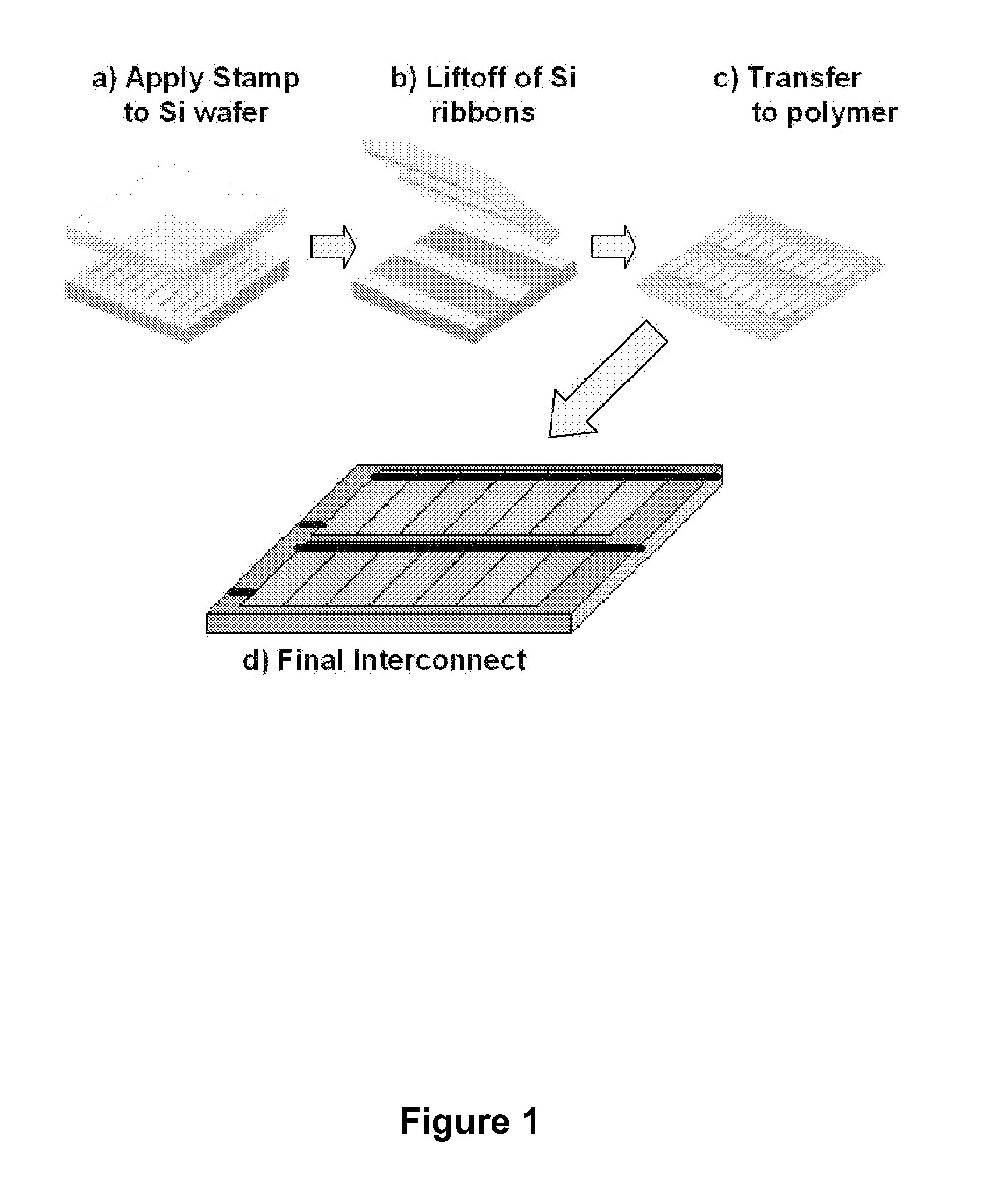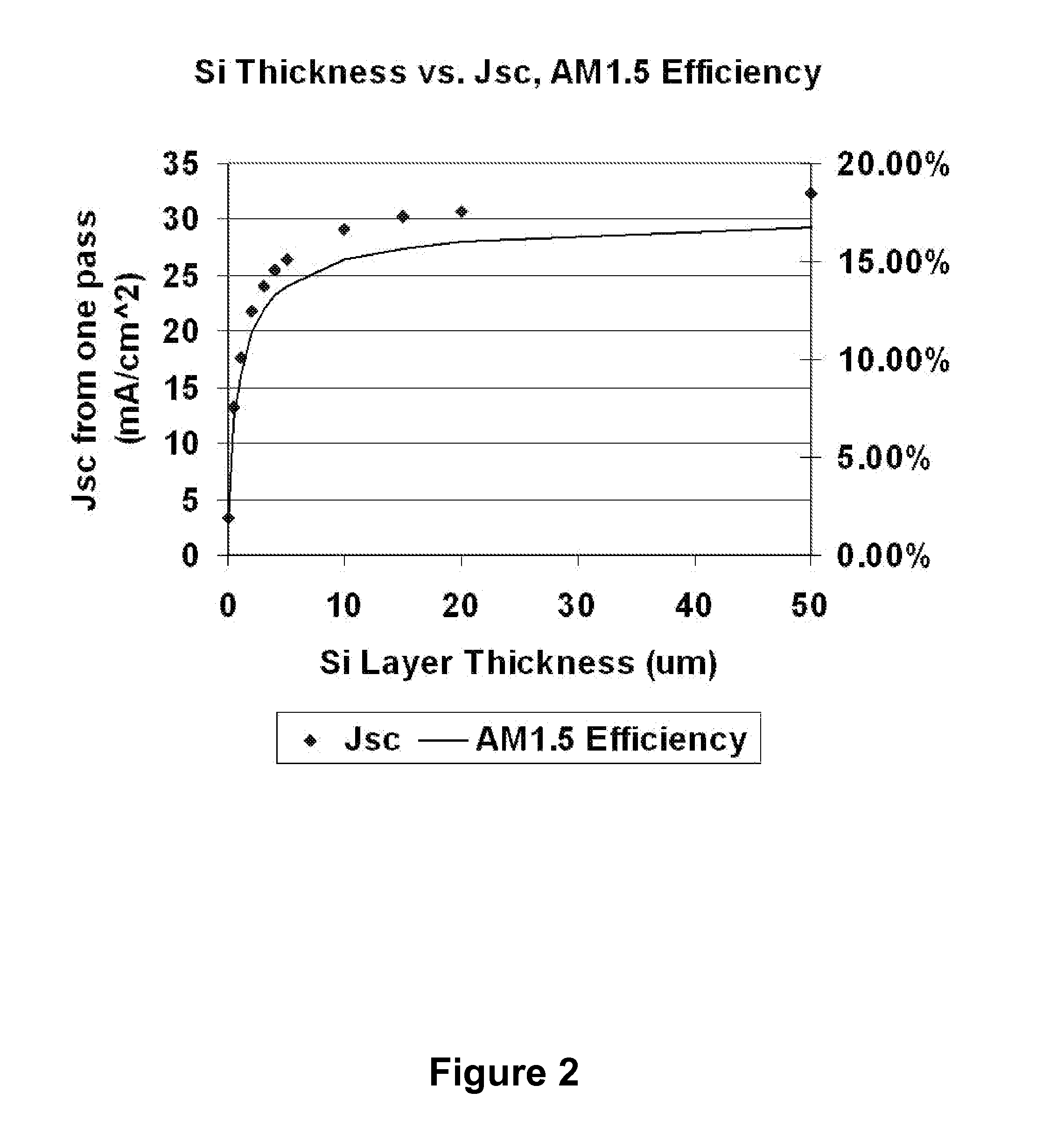Arrays of Ultrathin Silicon Solar Microcells
a solar cell and array technology, applied in the field of arrays of ultrathin silicon solar cells, can solve the problems of major cost, rate and energy input driver in the production of materials, serious limitations in the industry, and short supply period of electronic-grade si, and achieve convenient transportation and installation characteristics, high efficiency, and low cost. the effect of sacrificing efficiency or performan
- Summary
- Abstract
- Description
- Claims
- Application Information
AI Technical Summary
Benefits of technology
Problems solved by technology
Method used
Image
Examples
example 1
Ultra Thin Flexible Solar (UTFS) Devices and Methods
[0097]There is currently interest in thin-film PV technologies, since these systems have the potential for lower cost (due to less active material usage), and also have the ability to be deposited onto polymer substrates for low weight and flexibility. Presently, investigation is ongoing in thin film materials such as amorphous silicon, cadmium telluride (CdTe) and copper indium gallium diselenide (CIGS). CIGS-based PV cells have demonstrated cell efficiencies of 19.2%, the highest of any polycrystalline thin film material. These cells are small, laboratory-scale devices; to date, the highest large-area flexible module efficiencies are on the order of 10%. Cheaper thin film semiconductors enable material cost savings, but induce higher processing costs as the cells need to be fabricated / processed on large area substrates. Also, only low / moderate temperature processes can be used on the final assembly substrate
[0098]Ideally, one wou...
example 2
Arrays of Monocrystalline Silicon Solar Microcells for Modules With Ultra-Thin, Mechanically Flexible, Semi-Transparent and Micro-Optic Concentrator Designs
[0125]Silicon, in amorphous or various crystalline forms, is used in >90% of all installed photovoltaic (PV) capacity. The high natural abundance of silicon, together with the excellent reliability and good efficiency of solar cells made with it suggest its continued use, on massive scales, for the foreseeable future. As a result, although there is significant promise for organics, nanocrystals, nanowires and other new materials for photovoltaics, many opportunities continue to exist for research into unconventional means for exploiting silicon in advanced PV systems. This example describes modules that use large scale arrays of silicon solar micro-cells (μ-cells) created from bulk wafers and integrated in diverse spatial layouts on foreign substrates by transfer printing. The resulting devices can offer useful features, includin...
example 3
Fabrication of Si Microbar Cells (μb-cells)
[0202]An anisotropic wet etching process provides a simple means to create ultrathin, monocrystalline Si cells from bulk wafers of material. FIG. 30 shows the process for forming the thin Si[11,12], which begins with patterning of lines of resist on the surface of a (111) Si wafer. (Published data indicate no differences in efficiency for conventional cells made with (111) compared to (100) Si.[35,36]) A vertical trench etch followed by an anisotropic undercut etch (e.g. tetramethyl ammonium hydroxide, which etches along the direction ˜50× faster than other directions) yields bars or ribbons of Si that remain attached to the underlying wafer only at their ends. The vertical etch defines the thicknesses of the bars / ribbons; the patterning step defines the lengths, widths and spacings.
[0203]In this process, the etching procedures for the vertical trenches and undercuts yield structures that utilize up to 85% of the available Si. Doping techn...
PUM
 Login to View More
Login to View More Abstract
Description
Claims
Application Information
 Login to View More
Login to View More - R&D
- Intellectual Property
- Life Sciences
- Materials
- Tech Scout
- Unparalleled Data Quality
- Higher Quality Content
- 60% Fewer Hallucinations
Browse by: Latest US Patents, China's latest patents, Technical Efficacy Thesaurus, Application Domain, Technology Topic, Popular Technical Reports.
© 2025 PatSnap. All rights reserved.Legal|Privacy policy|Modern Slavery Act Transparency Statement|Sitemap|About US| Contact US: help@patsnap.com



